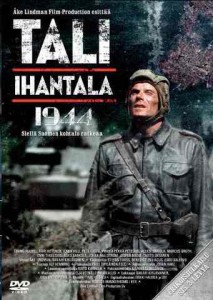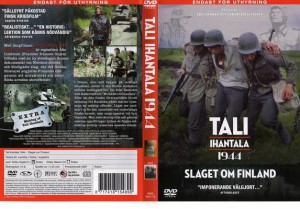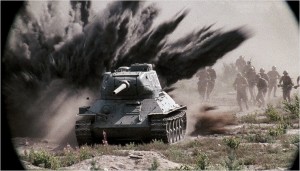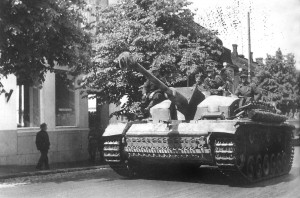
Tali Ihantala 1944
First, for those not familiar with the Russo-Finnish War, the battle of Tali-Ihantala 1944 (June 25 to July 9, 1944) was part of the Continuation War (1941-1944), fought by Finland, supported by Germany, against the Soviet Union and is to date the largest battle in the history of the Nordic countries. The battle ended in a decisive Finnish victory. In the battle, 6 Finnish Divisions (5 Infantry and the Finnish Armoured Division under Maj. Gen. Ruben Lagus) fought 4 Corps of the Red Army to a standstill in a small area (100 km²) between the northern tip of the Bay of Viipuri and the River Vuoksi around the villages of Tali and Ihantala, 8-14 km north-east from Vyborg.
Before I jump to a review of the film, I’ve included a history lesson following my review of the film – a summary of the battle and why it was so important to the survival of Finland. It’s a bit long but if you’re interested in the context of the Tali-Ihantala 1944 movie, it might help you understand a little more of what Ake Lindman, the director, was attempting to do.
OK, on to the movie…..and I have to say from the start that I’m a huge fan of Finnish war movies. I own Talvisota (Winter War), both versions of Tuntematon Sotilas, Beyond the Front Line, Ambush, Little Nurse and Promise (a film about the Finnish Lotta’s), as well as a number of other Finnish movies. Of all of these, Talvisota is by far and away the best, with the 1955 version of Tuntematon Sotilas a close runner up. So when Tali-Ihantala 1944 came out, I bought it direct from an online store in Helsinki (delivery from Finland has, in my experience, never been a problem, although the shipping cost is somewhat high).
Tali-Ihantala 1944 is another good Finnish war movie, made by director Åke Lindman, who also directed Framom Främsta Linjen (Beyond Enemy Lines). The film uses an impressive amount of WWII equipment and Ake Lindman’s ambition in making it was to accurately recount this historically decisive battle so that the memory would not be lost. So, similarly to “Beyond Enemy Lines,” this is more of a dramatized documentary than a narrative movie. Fact: every main character in the movie has a historical counterpart, and a lot of authentic equipment was used in the making of the movie. The events depicted are based on real occurrences during the Tali-Ihantala battles, taken from various sources. So for a start, the film is firmly grounded in real history. This is no schmaltzy Saving Private Ryan. This is the reality of war as it was fought. You get no Rambos, no cheese, no political uber-correctness, no obligatory love interest, nothing but war as it realistically should be, within production limitations of course.

DVD Cover – Tali Ihantala 1944
Pros: The main features of the movie are the documentary-like battle scenes. One thing to note is that it’s obvious the movie makers didn’t have access to all that many tanks, as it can clearly be seen the same tanks are reused to portray tanks on both sides. It’s not a big issue given the authenticity of the tanks to begin with though, and someone not more familiar with it all probably wouldn’t even notice. Most of the battle scenes are infantry-related, which comes as no surprise since not only are they the easiest and cheapest to make, but also because infantry was the main component of the Finnish army, Finnish armored and air force units were very limited in size. These infantry scenes are decently made, if nothing spectacular. Still, for many battles I ended up wishing for more sheer manpower on the screen, both for the visuals of it as well as for historical accuracy. The action scenes are plentiful and often exciting. There’s a lot of footage of historically accurate T-34/85s and even an extremely rare (nowadays) T-34/76. Also look for StugIII’s, a JSU-152, and a KV-I’S. Great stuff. Refreshingly, at least for viewers like me who are fed up with CGI, there is very little computer-generated anything in this film. In fact, I don’t think there really was any at all besides a quick flyover by a Soviet plane or two.
Cons: As a dramatized documentary, the movie lacks a clear storyline. There’s no real plot or theme to the movie beyond sticking to the historical events. It’s a series of vignettes that seems to have been strung together with no real narrative to provide a common link. There are no central characters that remain throughout the movie, no character development. Characters that are shown are those in the units engaged in the battle at each time. A similar approach was used in “Thin Red Line” where there were no main characters either, but “Thin Red Line” was more of an artsy movie and Tali-Ihantala is definitely not artsy – so it doesn’t work to well. Example: You’ll see a 10-minute vignette such as that of a forward artillery observer who gets wounded. When the Russians overwhelm his position, he runs off into the forest and the film never mentions him again! He’s not the only one – this happens to every character! There is no closure or any attention given to anybody.
The action scenes feel sloppy and are haphazardly staged, and often (in spite of lots of great period armor) look quite cheap as well! The film even has to rely on stock footage for its portrayal of the German air assault later in the film. It makes you wonder why they even bothered including this as a subplot, as it adds absolutely nothing! We don’t even get a sense of the damage being done or the amount of lives lost until the final shot in the film – which is just too little, too late. The immediacy just isn’t there – especially when there’s only a couple dozen extras as soldiers (with no ammo packs or anything, mind you) when there should be thousands! Another criticism was with the artillery related shots – the Finnish Army used massive amounts of artillery in this battle, dumping tons of HE into very small areas – you just don’t get a sense of this from the move, which is a shame as it was the skilled use of Artillery by the Finns that broke the back of the Soviet attack.The film could really have used some means for communicating the course of the overall battle. The use of an HQ as a central theme to convey what was happening overall for example, but the director didn’t use such a device and it detracts from the film.
Also, the English subtitles had some annoying missteps evident in too many Finnish DVD productions; incorrect terminology and desperate attempts to make Finns speak UK English, whereas Finns in my experience speak more like Americans with their colorful expressions.
Conclusion: I enjoyed the film myself. Knowing the historical context and having read in some detail about the actual battle, I could make sense of the movie. Without that knowledge, it would be very difficult for the average viewer to make sense of what was going on. Perhaps for the Finnish audience, with their knowledge of Finnish history, this is not so important, but for the non-Finn, it seriously detracts from the movie. To enjoy this film, you really need to enjoy war movies and you need to be interested in Finnish war history. If you do, I recommend it highly. If you do not, choose something else. Even with the budget-imposed limitations and often less than stellar acting, it was well worth watching for someone familiar with the events and with a keen interest on the whole war era.
OK, that was the review. Here’s the history lesson.
After the initial Finnish advance of 1941, the Continuation War was stabilized with very little activity on either side. When the Siege of Leningrad was lifted in January 1944, Stavka received orders to plan an offensive against Finland to push it out of the war. The Soviet attack on the Finnish front commenced on the Karelian Isthmus on June 9, 1944, (coordinated with the Allied Invasion of Normandy). Three armies were pitted against the Finns, among them several experienced Guard formations.
The attack soon breached the Finnish front line at Valkeasaari on June 10 and the Finnish forces retreated to their secondary defence line, the VT-line (Vammelsuu-Taipale). The Soviet attack was supported by a massive artillery barrage, air bombardments and armoured forces. The VT-line was breached in Sahakylä and Kuuterselkä on June 14 and after a failed counterattack in Kuuterselkä by the Finnish armoured division the Finnish defence had to be pulled back to the VKT-line (Viipuri (Vyborg) – Kuparsaari – Taipale). The abandonment of the VT-line was followed by a week of retreat and delaying battles. The Soviet offensive was crowned when the city of Viipuri (Vyborg) was captured by the Soviets on June 20 after only a short battle. Despite the Red army’s great success in smashing two Finnish defense lines and capturing of territory in just 10 days, it failed to destroy the Finnish army which could concentrate on the VKT-line. On June 21 Stavka ordered the Leningrad front to breach the VKT-line at Tali (Paltsevo), and to advance to Lake Saimaa.

Soviet tanks advancing – Tali Ihantala 1944
The fighting in the area actually began on June 20. The first phase of the battle (June 20th – June 24th) was a defensive battle that the Finnish 18th division (Finnish 6th and 48th regiment and 28 independent battalion) and 3rd brigade (4 battalions) and the 3rd battalion of the 13th regiment (Swedish speaking) fought against the Soviet 97th and 109th army corps and 152nd tank brigade. The defenders were hit especially hard by artillery and air attacks, but managed to put up a strong defense that stalled the Soviet advance long enough for Finnish reinforcements to join the battle.
The second phase (June 25th – June 26th) was the start of the battle proper. The action started with a heavy artillery bombardment and air attack, followed by a major Soviet offensive from Tali village on the 25th of June. The goal of the attack was to reach Imatra-Lappeenranta-Suurpäälä before the 28th of June. The 30th Soviet Guards Army Corps had now also joined the battle. The Soviet army tried a breakthrough along both sides of the Lake Leitimojärvi. The attack on the eastern side of the lake was stopped after 3 kilometers by the Finnish 4th Division. On the west side the Soviet infantry of the 45th guards division and the 109th army corps got stuck in defensive positions around the hills of Konkkalanvuoret defended by the Finnish regiment JR48. However, Soviet tanks from the 27th tank regiment were able to force their way to the Portinhoikka crossroads. The Soviets also attacked with the 178th division over the Saarela strait who was defended by 1st battalion of the Finnish regiment JR6 but the attack was thrown back here as well.
Meanwhile, the 97th army corps attacked the 3rd brigade’s positions but got little ground. At this stage the situation was very critical for the Finns whose units were at risk of being cut off and surrounded. This would inevitably have led to defeat of the Finnish 4th army corps and the loss of the VKT line. The Finnish were able to organize a counterattack with the reserves of the 18th division, parts of the 17th division and some battle groups from the 4th division. Later on the afternoon the Finnish armored division joined the battle and managed to push the Soviet attackers on the west side of the Lake Leitimojärvi back to their starting point. The Soviet 27th tank regiment was annihilated apart from 6 tanks that were captured by the Finns.

Sturmgeschütz Brigade 303
In the third phase (June 27th – June 30th) more Finnish units joined the battle along with the German 303rd Sturmgeschütz brigade. The Finnish units had been spread out and mixed in the battle, which made the organisation of a concentrated defence difficult. The Finnish units were therefore reorganised into two battle groups, BG Björkman and BG Puroma. The Soviets also reinforced their forces with the 108th army corps. At this stage the Soviet forces included at least 1 armored brigade, 2 armored breakthrough regiments and 4 assault gun regiments. The Finns tried to regain the initiative by attacking the 4 Soviet divisions (46th Guard, 63rd Guard, 64th Guard, 268 division and the 30 guard tank brigade) – who had broken through east of Leitimojärvi – from three directions in order to make a motti of the Soviet divisions. The two battle groups, Björkman and Puroma, did manage to advance to within 1 kilometer of each other but failed to surround the Soviet divisions who had set themselves up into a hedgehog defense around Talinmylly. The Finnish attack failed because of heavy Soviet resistance especially with massed tanks and artillery and because the communication between several of the battalions broke down during the attack. Colonel Puroma said after the war that the one thing he regretted was the failure to make a motti out of Talinmylly.
The attack gave the Finnish defenders 72 hours of respite at the same time as the fresh Finnish 6th and 11th divisions reached the battlefield. Several tank battles took place during this fighting. On the 28th of June, the Air activity was high on both side as Finnish bombers and German Stukas pounded Soviet formations. The Soviet Air Force also attacked from the air and hit the staff of the Finnish armored division hard with bombers from the 276th Soviet bomber division. On June 28th the Finnish commander Oesch gave the order that the Finnish units should withdraw back to the line Vakkila-Ihantalajärvi-Kokkoselkä-Noskuanselkä (still within the VKT line), but they became caught up in a new Soviet offensive. June 29th was the hardest and the worst day for the Finns during the whole battle, and defeat was not far off. The Finnish forces finally managed to restore the line on June 29th after very bloody fighting. On June 30th the Finnish forces retreated from Tali. The heaviest fighting took place between July 1st and July 2nd when the Finns lost some 800 men per day.
Ihantala: July 1-July 9: The ensuing Finnish concentration of artillery fire was the heaviest in the country’s military history. It was based on the famed fire correction method of a Finnish Artillery General Vilho Petter Nenonen which enabled easy fire correction and quick changes of targets. At the critical Ihantala sector of the battle the Finnish defenders managed to concentrate their fire to the extent of smashing the advancing Soviet spearhead. According to Bitva za Leningrad 1941-1944 (“The Battle of Leningrad”) edited by Lieutenant General S.P. Platonov: “The repeated offensive attempts by the Soviet Forces failed … to gain results. The enemy succeeded in significantly tightening its ranks in this area and repulse all attacks of our troops … During the offensive operations lasting over three weeks, from June 21 to mid-July, the forces of the right flank of the Leningrad front failed to carry out the tasks assigned to them on the orders of the Supreme Command issued on June 21.”
By this time the Finnish army had concentrated half of their artillery in the area, along with the army’s only armoured division, with StuG III assault guns as the units primary weapon and the German 303 assault gun brigade. The defenders now finally had the new German anti-tank weapons that were previously kept in storage. On July 2 the Finns intercepted a radio message, according to which the Soviet 63rd Division and 30th Armored Brigade were to launch an attack on July 3. The following morning, two minutes before the supposed attack, 40 Finnish and 40 German bombers bombed the Soviet troops, and 250 guns fired total of 4,000 artillery shells into the area of the Soviet concentration. On the same day, 200 Soviet planes and their infantry attacked against the Finnish troops. By 19:00 the Finnish troops had restored their lines.
On July 6 the Soviet forces had some success, despite the Finnish 6th Division having 18 artillery battalions and one heavy battery for their defence. However, the Soviets were thrown back on the following day, and their counterattacks at 13:30 and 19:00 that day did not amount to anything. By July 7 the focus of the Soviet attacks was already moving to the area of Vuoksi and the Soviets now began transferring their best troops to Estonia, to fight the Germans. From July 9th on the Soviet troops no longer attempted a break-through. Nevertheless, some fighting continued.
Related operations: At the same time, the Soviet 59th Army attacked across the islands of the Bay of Viipuri from July 4th on, but the attack to the mainland was thrown back to the sea by the German 122nd Division on July 10th. After the Soviet failure at Tali on July 3, the Soviet 23rd Army attempted a crossing of the River Vuoksi on July 4 at Vuosalmi, but was not able to expand the beachhead, despite the fact that it had three divisions there against the Finnish 2nd Division. The Soviet breakthrough attempts continued there until July 21st.
In addition to the defensive victory gained at Tali-Ihantala, the front line held fast at Kivisilta and Tienhaara to the north of the Bay of Viipuri, and at Vuosalmi on the shores of the River Vuoksi. Further defensive victories were achieved at the Bay of Viipuri and on the northeast side of the Lake Ladoga, and in the Battle of Ilomantsi the Finns were able to encircle two Soviet divisions.On July 12, the Soviet troops received an order to stop their attempts to advance and to dig in. Soon, the Finnish scouts noticed trains with empty trucks advancing towards the city of Viipuri to take troops away from the Finnish front. They were needed for the great push towards Berlin. By July 12th the Soviet Union was ready to discuss peace terms with Finland.
What was the impact of Tali-Ihantala: The Battle of Tali-Ihantala, along with other successful Finnish victories achieved during the period, finally convinced the Soviet leadership that conquering Finland was going to be extremely hard, and not worth the cost. The Red Army had concentrated an overwhelming force against Finland and failed. The Battle of Tali-Ihantala was possibly the single most important battle fought in Finland’s Continuation War, as it largely determined the outcome of the entire war – or more precisely, the final outcome of two sequential wars, including the Winter War of 1939-1940 – and the following and final peace negotiations between Finland and the Soviet Union, while World War II was still going on.
Some of the reasons leading to the Soviet failure were that the Finns were able to intercept Soviet radio messages and forewarn and prompt the Finnish Army to put a firmly resolved defense. Also, the existence of the Finnish Salpa Defence Line was an important matter in the peace negotiations in Autumn 1944. What had taken place on the Finnish Karelian Isthmus in the end of the summer 1944, led to the final peace talks between Finland and the Soviet Union, and to Finland’s continued existence as an independent nation. The cease-fire between the Soviet Union and Finland began on September 4, 1944.
All in all, as a film Tali-Ihantala 1944 isn’t that enthralling a movie. The Plot is weak to non-existent, a device to connect the various parts doesn’t exist – there’s just no coherent story. On the other hand, as a historical record it isn’t bad. If you have read about and have an understanding of the battle, the scenes from the film can be followed and are well done in and of themselves as a series of scenarios within the overall battle.
 Copyright secured by Digiprove © 2013 Alternative Finland
Copyright secured by Digiprove © 2013 Alternative Finland


